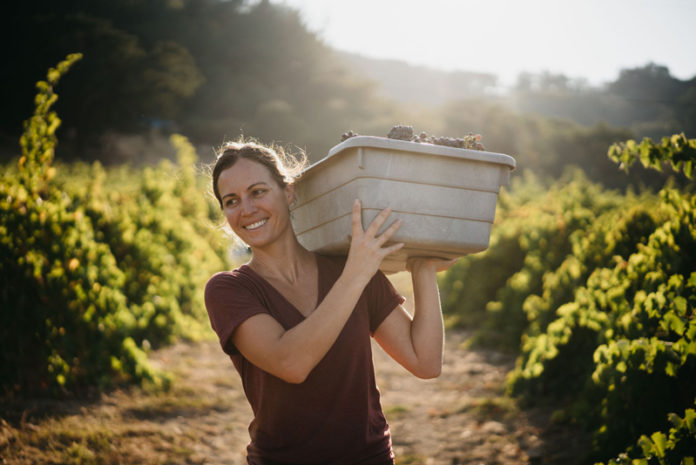There are certain places where the English language falls short. Wine is such a place. How to describe its aroma? No English speaker seems to know. So we uncrumple our grocery lists and recite fragrant produce items. Texture words, too, are scarce. Likening wine to sandpaper — is this really the best we can do?
It’s fitting, then, that Martha Stoumen, a native Californian and one of the country’s most celebrated winemakers, is equally difficult to put into words. There’s really no simple way to describe her mix of intensity and ease, brio and grace. If wisdom is what redeems us when we’re old and weary, then Martha, it would seem, has jumped the line.
Martha grew up in Sebastopol, Calif., in the heart of Sonoma County, which makes her path to wine notably circuitous. As an undergraduate at UCLA pursuing a dual degree in environmental studies and geography, she became fascinated by food systems. She credits her professor Judith Carney — author of In the Shadow of Slavery: Africa’s Botanical Legacy in the Atlantic World — who instilled in her the foundational idea that food was part of a broader sphere of human activity, shaped by social, economic, and political forces.
After college, Martha moved to Tuscany to work on a small agricultural estate and learning center. She harvested grains, cared for animals, and tended an olive grove, an experience that granted deeper resonance to everything she’d come to believe in. The estate also included a vineyard — and while Martha didn’t make any wine during her stay, the vines — and the communal, almost devotional activities they seemed to inspire — mesmerized her. As a Californian, she’d always seen wine as a commercial good, detached from nature and community — yet here it was a vital part of a wild, buzzing landscape. It was food; it was life.
By the time Martha returned home to Sonoma, awe had hardened into determination: She was going to learn how to make wine. So she set out in search of a winery position, an endeavor that could have been complicated by the fact that she’d never actually set foot in a winery. But Martha possessed a surprisingly sophisticated understanding of wine thanks to her undergraduate studies and farming background — and within a few weeks, she’d landed her first job in production. She was off to the races.
There are two archetypal paths to becoming a winemaker in America. The first is academic — the pursuit of wine as a scientific and commercial enterprise, often in a classroom. The second is vocational — a blend of cultural immersion and on-the-job-training, in which the aspiring winemaker seeks mentorship around the world, often pinging between the Northern and Southern hemispheres to squeeze in two harvests per year. Over the better part of the next decade, Martha would pursue both paths simultaneously, earning a master’s in viticulture and enology at UC Davis — her second double degree — while apprenticing under pioneers like Reinhard Löwenstein (Heymann-Löwenstein) in the Mosel and Didier Barral (Domaine Leon Barral) in Languedoc-Roussillon.
However, it was Sicilian winemaker Giusto Occhipinti of COS who provided the blueprint for what would later become Martha Stoumen Wines. It was food systems applied to natural wine — a holistic and compassionate approach to farming, production, and business. Sure, Occhipinti’s wines spoke of Sicily, but they also spoke of Giusto, reflecting his spirit of imagination and play.
Since 2014, Martha has been producing wine under her own label, working out of a shared facility in Sebastopol, just a few miles from where she grew up. Of all her wines, the one that consistently stands out for me is her Venturi Vineyard Carignan — sourced from a quartz-flecked riverbed in Mendocino, a former tributary of the Russian River. The wine is elegant in the way nature is elegant, a beauty that feels more observed than imagined. “Rocks and moon dust,” she says.
Owning vineyards isn’t an option for most young winemakers working in America today — which is to say, without trust and shared values, wines like Martha’s couldn’t exist. For example, her Venturi Vineyard Carignan is born from her partnership with Larry Venturi, a dyed-in-the-wool Mendocino rancher whose family has been farming grapes in and around the town of Calpella, just south of Redwood Valley, since his grandfather arrived from Tuscany in 1917.
But far from bemoaning this reality, Martha sees these intergenerational, intercultural relationships as the bedrock of California wine. So she invests in them — much like a producer in the Loire Valley would be wise to invest in an inherited plot of vines.
Late in the summer of 2020, Venturi Vineyard caught fire. Grape vines, with their neat rows and manicured canopies, aren’t as flammable as you might think. However, Larry’s — head-trained, dry-farmed, beautifully unkempt — were an exception. Just when the flames were starting to take hold, a firefighting aircraft appeared high overhead. But Larry knew better than to hold his breath. With forests and towns burning across much of the region, it was painfully obvious that the plane was headed to one of the major fires nearby. Which made what happened next all the more astonishing: The sky bloomed with bright, rust-colored foam as fire retardant rained down over the vineyard.
It turned out that the plane had indeed been dispatched to fight a larger fire, but at the last minute was rerouted. On the return flight, the pilot happened to catch sight of the fire breaking out in Larry’s vineyard, and requested permission to release some of his payload. A split-second decision, a 70-year-old vineyard saved.
Martha didn’t harvest any Carignan that year, as the grapes had been baked on the vine. “They tasted like cooked jam,” she said, recalling their haunting sweetness.
For most winemakers, the story of wine is the story of a landscape. Not so for Martha. After 14 consecutive harvests in California, she sees wine as the condition of being human. It’s the people, the relationships, the whole circuit of culture and values that tie grower and winemaker together. Or maybe it’s something she can’t quite put into words.


